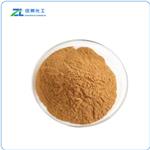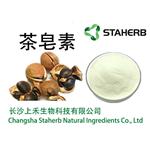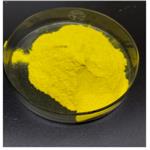Saponin
- CAS No.
- 8047-15-2
- Chemical Name:
- Saponin
- Synonyms
- saponins;QUILLAIA EXTRACT;Diosgenine;C57H90O26;Tea Saponins;SAPONIN POWDER;Quillaja saponin;sapogenins glycosides;Saponi;SAPONIN
- CBNumber:
- CB9393639
- Molecular Formula:
- C27H42O3
- Molecular Weight:
- 0
- MDL Number:
- MFCD00081981
- MOL File:
- Mol file
- MSDS File:
- SDS
| Melting point | 158℃ |
|---|---|
| Boiling point | 101.9℃[at 101 325 Pa] |
| Density | 1.015-1.020 g/mL at 20 °C (5% in H2O)(lit.) |
| vapor pressure | 0.009Pa at 105℃ |
| storage temp. | Store at RT. |
| form | Tan solid |
| color | Yellow crystalline |
| Odor | Odorless |
| Water Solubility | Soluble in cold water. |
| Merck | 14,8365 |
| Stability | Stable. Incompatible with strong oxidizing agents. |
| LogP | -0.24 at 20℃ |
| EWG's Food Scores | 1 |
| NCI Dictionary of Cancer Terms | saponin |
| EPA Substance Registry System | Saponins (8047-15-2) |
SAFETY
Risk and Safety Statements
| Symbol(GHS) |  GHS07 |
|||||||||
|---|---|---|---|---|---|---|---|---|---|---|
| Signal word | Warning | |||||||||
| Hazard statements | H319-H335 | |||||||||
| Precautionary statements | P261-P264-P271-P280-P304+P340+P312-P305+P351+P338 | |||||||||
| Hazard Codes | Xi | |||||||||
| Risk Statements | 36/37-36/37/38 | |||||||||
| Safety Statements | 26-37/39-36 | |||||||||
| WGK Germany | 2 | |||||||||
| RTECS | VQ1400000 | |||||||||
| F | 3 | |||||||||
| TSCA | Yes | |||||||||
| HS Code | 29389090 | |||||||||
| NFPA 704 |
|
Saponin price More Price(35)
| Manufacturer | Product number | Product description | CAS number | Packaging | Price | Updated | Buy |
|---|---|---|---|---|---|---|---|
| Sigma-Aldrich | 558255 | Saponin-CAS8047-15-2-Calbiochem Aglycosideusedtopermeabilizecellularmembranes.Exhibitshemolyticactivity | 8047-15-2 | 100g | $106 | 2024-03-01 | Buy |
| Sigma-Aldrich | 47036 | Saponin for molecular biology, used as non-ionic surfactant | 8047-15-2 | 50g | $112 | 2024-03-01 | Buy |
| Sigma-Aldrich | 47036 | Saponin for molecular biology, used as non-ionic surfactant | 8047-15-2 | 250g | $459 | 2024-03-01 | Buy |
| TCI Chemical | S0019 | Saponin | 8047-15-2 | 25g | $39 | 2024-03-01 | Buy |
| TCI Chemical | S0019 | Saponin | 8047-15-2 | 250g | $297 | 2024-03-01 | Buy |
Saponin Chemical Properties,Uses,Production
Description
Saponin is a secondary metabolite that facilitates the penetration of proteins through the cell membrane. Studies indicate that saponins are amphipathic glycosides, which can act as hemolytic agents. Research indicates that Saponin displays antinociceptive, anti-inflammatory and antipyretic activities, which may be due to its nonglycosidic moiety, sapogenin. Saponin can also be used in environmental research to recover chromium and other metals from sludge samples. Additional studies indicate that Saponin is useful in immunoassays since it can stimulate the Th1 immune response and the production of cytotoxic T-lymphocytes in response to exogenous antigens.
structure and hydrogen bonding
The aglycone (glycoside-free) portions of the saponins are termed sapogenins. The number of saccharide chains attached to the sapogenin/aglycone core can vary – giving rise to another dimension of nomenclature (monodesmosidic, bidesmosidic, etc.) – as can the length of each chain. A somewhat dated compilation has the range of saccharide chain lengths being 1–11, with the numbers 2–5 being the most frequent, and with both linear and branched chain saccharides being represented. Dietary monosaccharides such as D-glucose and D-galactose are among the most common components of the attached chains.
The lipophilic aglycone can be any one of a wide variety of polycyclic organic structures originating from the serial addition of 10-carbon (C10) terpene units to compose a C30 triterpene skeleton, often with subsequent alteration to produce a C27 steroidal skeleton. The subset of saponins that are steroidal have been termed saraponins. Aglycone derivatives can also incorporate nitrogen, so some saponins also present chemical and pharmacologic characteristics of alkaloid natural products. The figure at right above presents the structure of the alkaloid phytotoxin solanine, a monodesmosidic, branched-saccharide steroidal saponin. (The lipophilic steroidal structure is the series of connected six- and five-membered rings at the right of the structure, while the three oxygen-rich sugar rings are at left and below. Note the nitrogen atom inserted into the steroid skeleton at right.)Originator
Saponins are phytochemicals which can be found in most vegetables, beans and herbs. The best known sources of saponins are peas, soybeans, and some herbs with names indicating foaming properties such as soapwort, saoproot, soapbark and soapberry. Commercial saponins are extracted mainly from Yucca schidigera and Quillaja saponaria.
Uses
Saponins are steroid or triterpenoid glycosides found in wild or cultivated plants, lower marine animals and some bacteria. Notably, saponins can also activate the mammalian immune system, which have led to significant interest in their potential as vaccine adjuvants. Their unique capacity to stimulate both the Th1 immune response and the production of cytotoxic Tlymphocytes (CTLs) against exogenous antigens makes them ideal for use in subunit vaccines and vaccines directed against intracellular pathogens as well as for therapeutic cancer vaccines.
Saponins are used in permeabilization of cell membranes and separation of low molecular weight contaminants and as an adjuvant in vaccine development.
Health Benefits
Saponins have many health benefits. Studies have illustrated the beneficial effects on blood cholesterol levels, cancer, bone health and stimulation of the immune system. Most scientific studies investigate the effect of saponins from specific plant sources and the results cannot be applied to other saponins.
Cholesterol reduction
Saponins bind with bile salt and cholesterol in the intestinal tract. Bile salts form small micelles with cholesterol facilitating its absorption. Saponins cause a reduction of blood cholesterol by preventing its re-absorption.
Reduce cancer risk
Studies have shown that saponins have antitumor and anti-mutagenic activities and can lower the risk of human cancers, by preventing cancer cells from growing. Saponins seem to react with the cholesterol rich membranes of cancer cells, thereby limiting their growth and viability.
Immunity booster
Plants produce saponins to fight infections by parasites. When ingested by humans, saponins also seem to help our immune system and to protect against viruses and bacteria.
Reduce bone loss
Studies with ovariectomized induced rats have shown that some saponins, such as the steroidal saponins from Anemarrhena asphodeloides, a Chinese herb, have a protective role on bone loss.
Antioxidant
The non-sugar part of saponins have also a direct antioxidant acitivity, which may results in other benefits such as reduced risk of cancer and heart diseases.
Chemical Properties
Light yellow powder
Uses
Saponin is an amphipathic glycoside and surfactant.
Uses
Glycoside widely distributed in plants. Nonionic sufactant that forms oil-in-water emulsions and acts as protective colloid. Used for the direct determination of metals in milk by flame atomic-absorption spectrophotometry. Also used in permeabilization of cell membranes and separation of low molecular weight contaminants, and as an adjuvant in vaccine development.
Definition
saponin: A type of toxic glycosidethat forms a frothy colloidal solutionon shaking with water. Saponinsoccur in many plants (such as horsechestnut). They break down redblood cells and have been used forpoisoning fish. On hydrolysis theyyield a variety of sugars.
General Description
Saponins are natural steroidal glycoside (terpenes).
Flammability and Explosibility
Non flammable
Biochem/physiol Actions
Saponins solubilize the low density lipoprotein (LDL) fraction of cholesterol in micelles, thus lowering their concentration. Saponin from Quillaja bark is used as a flavoring agent in food and beverages. This saponin has been shown to enhance immune-cell proliferation in vitro.
Saponin Preparation Products And Raw materials
Raw materials
1of2
Preparation Products
1of2
| Supplier | Tel | Country | ProdList | Advantage | |
|---|---|---|---|---|---|
| Shaanxi Pioneer Biotech Co., Ltd . | +8613259417953 | sales@pioneerbiotech.com | China | 3000 | 58 |
| Henan Bao Enluo International TradeCo.,LTD | +86-17331933971 +86-17331933971 | deasea125996@gmail.com | China | 2503 | 58 |
| Hebei Zhuanglai Chemical Trading Co.,Ltd | +8613343047651 | admin@zlchemi.com | China | 290 | 58 |
| Henan Tianfu Chemical Co.,Ltd. | +86-0371-55170693 +86-19937530512 | info@tianfuchem.com | China | 21695 | 55 |
| Hangzhou FandaChem Co.,Ltd. | 008657128800458; +8615858145714 | fandachem@gmail.com | China | 9348 | 55 |
| Nanjing Finetech Chemical Co., Ltd. | 025-85710122 17714198479 | sales@fine-chemtech.com | CHINA | 885 | 55 |
| Shanghai Zheyan Biotech Co., Ltd. | 18017610038 | zheyansh@163.com | CHINA | 3620 | 58 |
| career henan chemical co | +86-0371-86658258 | sales@coreychem.com | China | 29914 | 58 |
| Shaanxi Yikanglong Biotechnology Co., Ltd. | 17791478691 | yklbiotech@163.com | CHINA | 296 | 58 |
| Hebei Guanlang Biotechnology Co., Ltd. | +86-19930503282 | alice@crovellbio.com | China | 8823 | 58 |
Related articles
- Properties and Biological functions of Saponin
- Saponins are secondary metabolites with high molecular weight. They present in a wide range of plant species and are distribut....
- Jul 21,2022
- Toxicity and extraction of Saponin
- Saponin also selectively referred to as triterpene glycosides, are bitter-tasting usually toxic plant-derived organic chemical....
- May 9,2022
- Uses of Saponin
- Demand for bean products is growing because of the presence of several health-promoting components in edible bean products suc....
- Feb 9,2022
View Lastest Price from Saponin manufacturers
| Image | Update time | Product | Price | Min. Order | Purity | Supply Ability | Manufacturer | |
|---|---|---|---|---|---|---|---|---|
 |
2024-04-23 | Saponin
8047-15-2
|
US $200.00-85.00 / kg | 1kg | 99% | 20ton | Hebei Zhuanglai Chemical Trading Co.,Ltd | |
 |
2024-04-23 | Tea Saponin
8047-15-2
|
US $0.00 / G | 100G | 1-98% HPLC | 1000kg | Changsha Staherb Natural Ingredients Co., Ltd. | |
 |
2024-04-23 | Saponin
8047-15-2
|
US $28715.00-28700.00 / Tons | 1Tons | 99.99% | 100Tons | Hebei Dangtong Import and export Co LTD |
-

- Saponin
8047-15-2
- US $200.00-85.00 / kg
- 99%
- Hebei Zhuanglai Chemical Trading Co.,Ltd
-

- Tea Saponin
8047-15-2
- US $0.00 / G
- 1-98% HPLC
- Changsha Staherb Natural Ingredients Co., Ltd.
-

- Saponin
8047-15-2
- US $28715.00-28700.00 / Tons
- 99.99%
- Hebei Dangtong Import and export Co LTD
8047-15-2(Saponin)Related Search:
1of4




